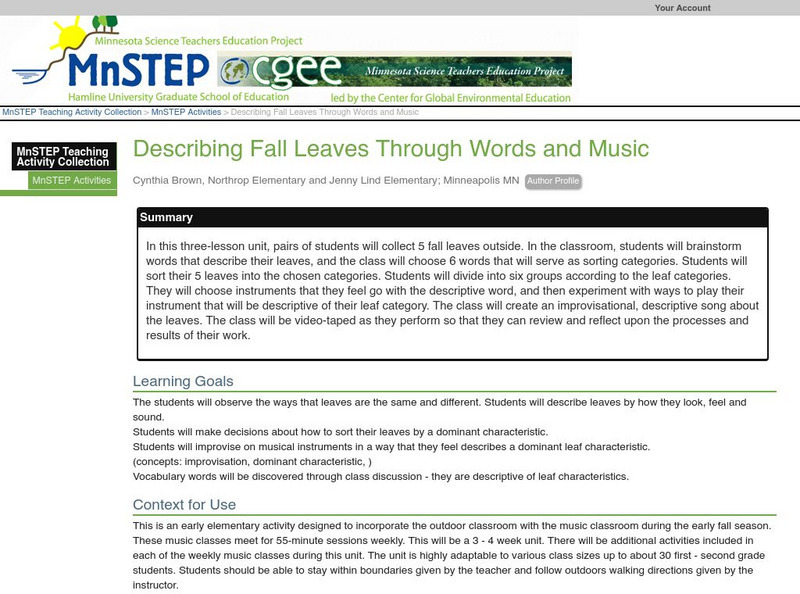Scholastic
Study Jams! Natural Resources
Use this slide show to introduce your class to some of our most useful natural resources. The text beneath the photographs differentiates between renewable and non-renewable resources. The need for conservation of resources and human...
Teach Engineering
Acoustic Mirrors
Investigate sound waves with acoustic mirrors. Using audio software, groups make recordings of musical instruments, both with and without acoustic mirrors. They compare the recordings to see the effect of acoustic mirrors on sound...
Curated OER
Sounds Like Music
Students define and examine the connections between sound and music and how engineers design instruments. They listen to examples of musical instruments, view a demonstration of a tuning fork and bottles filled with varying amounts of...
Curated OER
Water
Third graders study different bodies of water and how they fit into the water cycle. They explain that materials exist in different states (solid, liquid and gas) and change from one to another, that there are systems, order, and...
Curated OER
The Musical Mind
Students go on a tour of how and why music styles have changed over the years, and discover where they can gather some insight about their favorite musical styles and artists. There are excellent websites imbedded in this lesson.
Virginia Department of Education
Sound
Add a little music to your next physics class. Pupils discuss how frequency determines pitch and take part in several activities designed to teach them more about sound, melody, resonance, and vibrations. They use materials to construct...
Curated OER
Evaluating Music
Students identify an object by drawing something that reminds them of how they feel when they are calm or at peace. In this music lesson, students depict a musical instrument making peaceful music, and then an instrument making loud...
Curated OER
Nature's Magic Elixir
Students do research to discover the importance of water in the world and its effect upon our daily lives. They will also appreciate the beauty of water and how it is so adaptable within nature.
Curated OER
The Vibrational Nature of Sound
Students explore the vibrational nature of sound. For this science lesson plan, students gain an understanding of sound frequency, pitch, and conduction using the string telephone, tuning fork and musical glasses experiments.
Curated OER
Strum Along
Learners engage in a lesson which takes something constructed by the class, that would be normally classified as just sound, then work together to make what can be perceived to be music. Students construct a basic stringed instrument...
Curated OER
Experimenting with Sound
Young scholars explore physical science by completing a worksheet. In this sound perception instructional activity, students collaborate in small groups to research sound properties on the Internet and in libraries. Young scholars...
Curated OER
The Cigar Box Guitar
Pupils correlate string tension with sound pitch. They describe how string mass (thickness) effects sound pitch and demonstrate an understanding of the physics of the acoustic guitar. They see that sound is produced by vibrations.
Perkins School for the Blind
Learning to Identify Sounds Made by the Body
Sneeze, snap, tap, and whistle; Did I do that? Explore the parts and sounds of the human body with your learners with visual impairments. First you'll name the parts of the body, make a sound with each part, and then have the class...
Curated OER
Observing Sound
Second graders study the five senses and the link between pictures and sound. In this sound lesson plan students discover that sound is vibration, it is described by volume and pitch.
Curated OER
Fun With Sound
Second graders make predictions. In this sound lesson, 2nd graders listen to various sounds, and write down and draw what they think that sound is. Students make a chart of their predictions.
Curated OER
Trees at Work... Just Look!
Young scholars investigate the significance of trees. They collect magazine pictures of animals that live in trees, list products that are made from trees, collect twigs and create an item using the sticks, and bring in and discuss food...
Curated OER
Curricular Correlations
First graders listen to prerecorded sounds and put them into categories. They discus the sounds that would be heard outdoors, and indoors. They go outside for a few minutes and take a "hearing walk." Then they come inside and close their...
Curated OER
Raising Cane: Building a Cane Flute From Scratch
Eighth graders create their own cane flute. They use a model flute to gain the correct measurements and use the scientific method to construct the flute to have sound quality and pitch accuracy.
Curated OER
Kitty Tunes
Learners compare cat calls. In this wildlife lesson, students listen to cat calls and compose their own raps that feature the calls of Florida panthers.
Curated OER
Ocean Careers Investigation
Students gather information about different careers of the Ocean Adventures expedition team. For this career studies lesson students work in groups, read an interview with an Ocean Adventurer, and see the importance of working in a...
Curated OER
Larva and Adult Antlion Body Parts
Students identify the major body segments of antlions. Through the use of diagram worksheets, students label the various body parts of the antlion. They review the life cycle of antlions from the larva stage to adult. Several activities...
Physics Classroom
The Physics Classroom: Sound Wave and Music Table of Contents
Learners investigate the nature of a sound wave, sound properties, resonance, musical instruments, and standing waves. The tutorial consists of lessons and problems to check for understanding.
Physics Classroom
The Physics Classroom: Sound Waves and Music: Guitar Strings
A guitar string has a number of frequencies at which it will naturally vibrate. These natural frequencies are known as the harmonics of the guitar string. Students work through several example problems.
Science Education Resource Center at Carleton College
Serc: Describing Fall Leaves Through Words and Music
Students collect, describe, and sort leaves found outside. As a cross-curricular component, they will improvise on musical instruments in a way that they feel describes a dominant leaf characteristic.






















